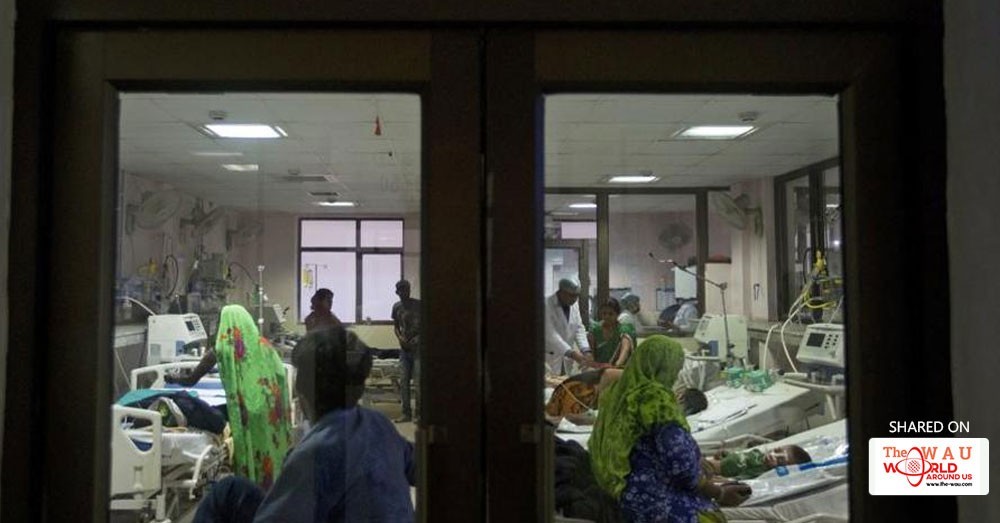In India, there is one government allopathic doctor for every 10,189 people, one government hospital bed for every 2,046 people and one state-run hospital for every 90,343 people.
You don’t need an epidemic, however predictable, for the public health system to collapse. It is a matter of routine that patients share beds and doctors are overworked.
India has a little over one million modern medicine (allopathy) doctors to treat its population of 1.3 billion people. Of these, only around 10% work in the public health sector, shows data from the National Health Profile 2017.
The shortage of health providers and infrastructure is the most acute in rural areas, where catastrophic health expenses push populations the size of United Kingdom into poverty each year.
Add apathy and you have bodies of the dead being mutilated by dogs in hospital morgues, people carrying home the their dead children because the hospital refused them a hearse, and tragedies like the hundreds of infant deaths in Gorakhpur’s Baba Raghav Das (BRD) Medical College every year.
BRD Medical College Hospital’s failure to save lives points to a systemic rot in public healthcare delivery, which is saddled with problems of mismanagement and inadequate resources — infrastructure and human.
Despite being routinely flagged, these shortages are seldom corrected. Learning from failure is rare, and course correction after mistakes is rarer.
Read Part 1 of series | Gorakhpur deaths: Why India’s poor public health delivery system is a killer
This brings us to critical questions: Can such deaths be prevented? How can India’s public health system deliver quality care? Will public hospitals just end up being places where the sick go to die?
Where are the doctors?
India doesn’t have enough hospitals, doctors, nurses and health workers, and since health is a state subject, disparities and inequities in the quality of care and access to health varies widely not just between states but also between urban and rural areas.

For example, Maharashtra has 1,53,513 registered doctors, the most in the country, compared to 792 registered with the Arunachal Pradesh Medical Council.
In the absence of doctors, the sick make do with whoever is available, irrespective of their qualifications.
Only one in five doctors in rural India are qualified to practice medicine, found a World Health Organization (WHO) report on India’s healthcare workforce, highlighting the widespread problem of quackery. The WHO report, published in 2016, said 31.4% of those calling themselves allopathic doctors were educated only up to Class 12 and 57.3% doctors did not have a medical qualification.
In India, self-styled doctors without formal training provide up to 75% of primary care visits. “We get very sick babies because most parents seek local remedies and treatment from quacks before they bring their children to hospital. We can’t turn anyone away so you’ll often find two to three babies on one bed or two babies in one incubator. We provide the best of care possible under the given circumstances, which is not enough at times,” said the new principal of BRD Medical College, Dr PK Singh.

“There are no large-scale surveys on quackery by national statistical agencies such as the Census of India or National Sample survey Office, which could form the basis for policy making in this area. The World Health Organization is the first comprehensive report on the health workforce in India and though it has been derived by decoding the 2001 Census data, the methodology and conclusions are sound,” said Shailaja Chandra, former chief secretary Delhi, who has worked in the Union health ministry and authored the report, Unqualified Medical Practitioners this year.
“The lack of medical qualifications was particularly high in rural areas. The report brought out that whereas 58% of the doctors in urban areas had a medical degree, only 19% of those in rural areas had such a qualification,” said Chandra.
The way ahead
“Strengthening primary healthcare hasn’t got the priority it needs and the sick reach hospitals after faith-healers, quacks and other unqualified practitioners fail to cure them,” said Sujatha Rao, former health secretary, Union Ministry of Health and author of Do we care? India’s health system. “With early diagnosis and timely referrals, many lives can be saved,” she said.

Training informal healthcare workers who had little-to-no training for nine months increased their ability to correctly manage cases, found a J-PAL 2016 study on The Impact of Training Informal Healthcare Providers in India. Trained informal workers provided correct case management in 60% cases compared to 52% of the comparison group, and 67% doctors at public health centres. The training, however, did not reduce the use of unnecessary medicines, found the study.
In the absence of doctors, quacks provide a service and cannot be wished away, says Chandra. “What we need is an updated assessment of quackery by state and district, better enforcement to ensure they don’t indulge in high-risk practices such as use of injections and IV fluids, and selective training so they cause least harm while improving access to first-line health care,” said Chandra.
Trained quacks, however, cannot replace doctors, and India is just not training enough. There are 462 medical colleges that teach 56,748 doctors and 3,123 institutions that prepare 1,25,764 nurses each year, but with India’s population increasing annually by 26 million, the numbers are too little.
“India keeps announcing new AIIMS-like institutes in states, but where is the faculty to train these doctors? Setting up a building and buying equipment is not enough, you need trained doctors to provide care,” said Rao.

Even the equipment bought is often not used. A Comptroller and Auditor General (CAG) report in June revealed a 27.21% shortage for clinical equipment and 56.33% for non-clinical equipment, of which oxygen supply is a part. The report found critical medical equipment had not been used for more than five years because there was no annual maintenance contract.
“Instead of training Ayush practitioners and quacks – every hospital compounder and ward boy becomes a self-proclaimed doctor after retirement – to prescribe allopathy medicine, we need to strengthen traditional systems of medicine to offer first line of treatment and care,” said Dr KK Aggarwal, president, Indian Medical Association.
Share This Post















